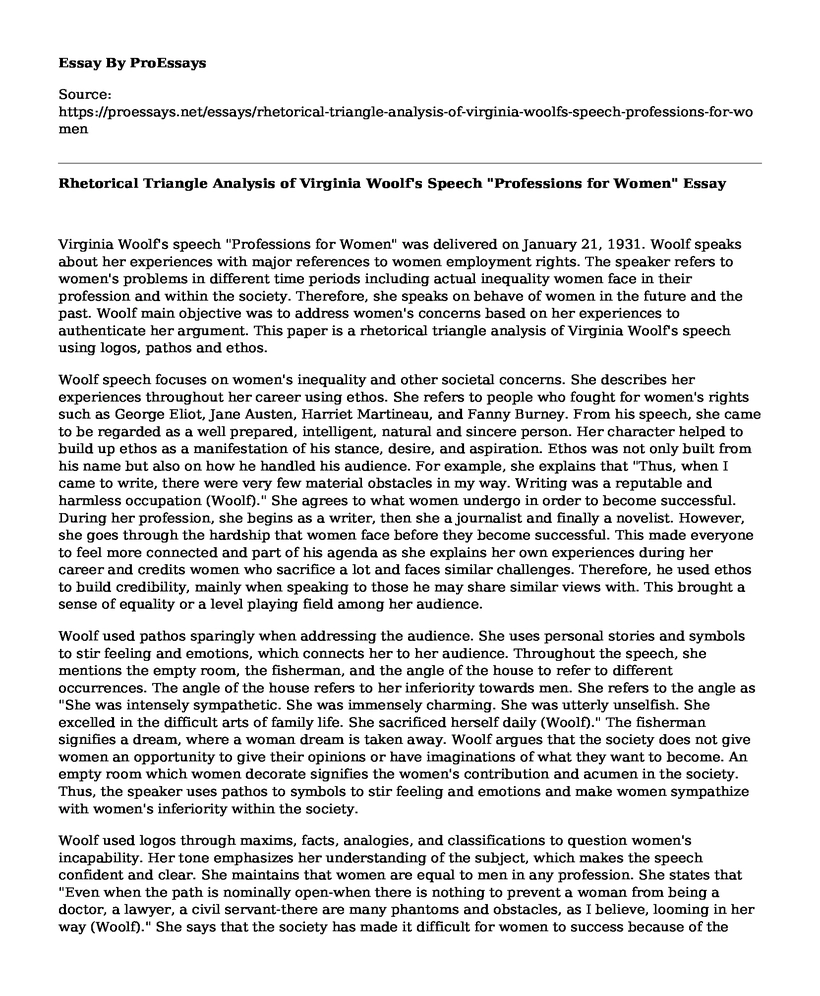Virginia Woolf's speech "Professions for Women" was delivered on January 21, 1931. Woolf speaks about her experiences with major references to women employment rights. The speaker refers to women's problems in different time periods including actual inequality women face in their profession and within the society. Therefore, she speaks on behave of women in the future and the past. Woolf main objective was to address women's concerns based on her experiences to authenticate her argument. This paper is a rhetorical triangle analysis of Virginia Woolf's speech using logos, pathos and ethos.
Woolf speech focuses on women's inequality and other societal concerns. She describes her experiences throughout her career using ethos. She refers to people who fought for women's rights such as George Eliot, Jane Austen, Harriet Martineau, and Fanny Burney. From his speech, she came to be regarded as a well prepared, intelligent, natural and sincere person. Her character helped to build up ethos as a manifestation of his stance, desire, and aspiration. Ethos was not only built from his name but also on how he handled his audience. For example, she explains that "Thus, when I came to write, there were very few material obstacles in my way. Writing was a reputable and harmless occupation (Woolf)." She agrees to what women undergo in order to become successful. During her profession, she begins as a writer, then she a journalist and finally a novelist. However, she goes through the hardship that women face before they become successful. This made everyone to feel more connected and part of his agenda as she explains her own experiences during her career and credits women who sacrifice a lot and faces similar challenges. Therefore, he used ethos to build credibility, mainly when speaking to those he may share similar views with. This brought a sense of equality or a level playing field among her audience.
Woolf used pathos sparingly when addressing the audience. She uses personal stories and symbols to stir feeling and emotions, which connects her to her audience. Throughout the speech, she mentions the empty room, the fisherman, and the angle of the house to refer to different occurrences. The angle of the house refers to her inferiority towards men. She refers to the angle as "She was intensely sympathetic. She was immensely charming. She was utterly unselfish. She excelled in the difficult arts of family life. She sacrificed herself daily (Woolf)." The fisherman signifies a dream, where a woman dream is taken away. Woolf argues that the society does not give women an opportunity to give their opinions or have imaginations of what they want to become. An empty room which women decorate signifies the women's contribution and acumen in the society. Thus, the speaker uses pathos to symbols to stir feeling and emotions and make women sympathize with women's inferiority within the society.
Woolf used logos through maxims, facts, analogies, and classifications to question women's incapability. Her tone emphasizes her understanding of the subject, which makes the speech confident and clear. She maintains that women are equal to men in any profession. She states that "Even when the path is nominally open-when there is nothing to prevent a woman from being a doctor, a lawyer, a civil servant-there are many phantoms and obstacles, as I believe, looming in her way (Woolf)." She says that the society has made it difficult for women to success because of the many "ghosts" and prejudices. The use of logos helps her connect to her audience and leaves them questioning the challenges and problems women go through in the society.
Conclusion
In summary, Virginia Woolf uses her personal opinions and experiences to describe the challenges women undergo in the society. Her argument is based on the current issues including the actual inequality and emotional inferiority. She questions the authority, which prevents women from thinking for themselves. She used logos, pathos and ethos to provide logical details about women employment rights. This helped to inspire women to be able to stand for their rights.
Works Cited
Woolf, Virginia. "Professions for women." January 21, 1931.
www.wheelersburg.net/Downloads/Woolf.pdf42.
Cite this page
Rhetorical Triangle Analysis of Virginia Woolf's Speech "Professions for Women". (2022, Dec 10). Retrieved from https://proessays.net/essays/rhetorical-triangle-analysis-of-virginia-woolfs-speech-professions-for-women
If you are the original author of this essay and no longer wish to have it published on the ProEssays website, please click below to request its removal:
- Biography of Laura C Redden Searing. Paper Sample
- Deconstructing the Concept Of "Special Populations" Article Analysis Essay
- The Temple of Zeus Essay
- Essay Sample on David Thoreau Citations
- Poetry Analysis Essay on Mary Oliver's Crossing The Swamp
- Animal Testing: Pros & Cons Examined - Research Paper
- Essay Example on Street Art: Social Messages Through Paint, Yarn and Stickers







